[Infographic] Calculating HR: The Benefits of an HRIS
From reducing turnover to boosting employee experience, you can do a lot for your organization as an HR professional. But if all of your time is eaten up by operational tasks like answering questions or tracking vacation time, you’ll never be able to take on more strategic initiatives.
What are the Benefits of HRIS?
An HRIS (human resources information system) can help you by automating many of the processes that consume valuable time in your HR department, saving you time and money. And that’s just one of the benefits.
In this infographic, we break down the savings and other benefits an HRIS could provide for your organization using a hypothetical company and a hypothetical HR professional, Caroline. With baseline averages, we calculated how much Caroline’s time is worth ($33/hour) and how much an average employee’s time is worth ($23/hour) at Caroline’s company. From there, we break down the numbers.
Take a look at the findings and see how much the right HR software can save your organization.
Download the free infographic now.
Automated Onboarding
First, we calculated the impact of automated onboarding software. The traditional onboarding process, with all of its paperwork and training, consumes about 11 hours of Caroline’s week whenever there’s a new hire.
But automating onboarding can cut that time investment by 50 percent, which adds up when you consider how many new hires your organization makes in a year:
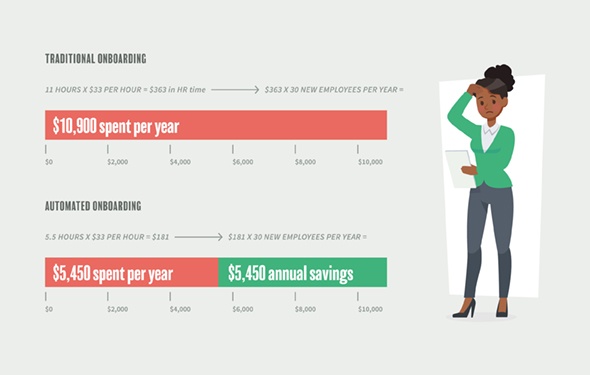
Automated onboarding can also boost your organization in other ways:
- Engagement- When employees believe their organization’s onboarding software is effective, they are 5x as likely to report high levels of engagement.
- Retention- Effective onboarding software boosts new hires’ confidence in their decision to join your organization, reducing turnover by as much as 30 percent.
- Performance & Productivity- Effective onboarding software decreases time-to-productivity by 33 percent.
E-Signatures
Documents and forms are an indispensable part of every HR department, but tracking down all those signatures can take up a lot of time—not to mention the headaches of lost paperwork or signature bottlenecks.
However, e-signature software can save an average organization up to 40 working hours each month. Plus, with digital documents, you can also save about $20 per document on printing and postage costs. Here’s how those numbers add up:
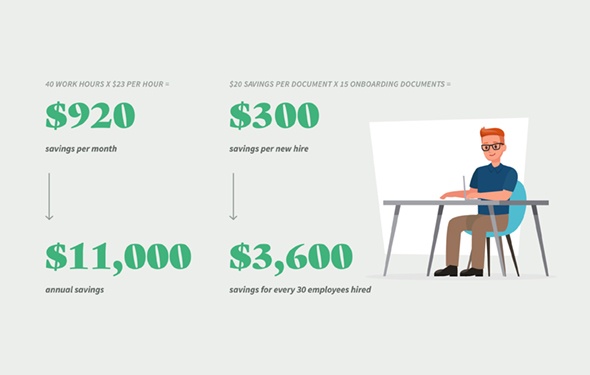
E-signature software offers a few other benefits as well:
- Efficiency- E-signature software reduces signed document turnaround times by as much as 90 percent.
- Employer Brand- Using e-signatures helps attract top talent, as 92 percent of young professionals would prefer to work for an environmentally friendly company.
Time-Off Management
Without time-off management software, Caroline (and many other HR professionals) has to keep track of employee vacation time using some version of a manual spreadsheet. Not only is this process incredibly time consuming, but it also leaves the organization at risk for inaccurate time-off tracking.
Whether by accident or on purpose, an average employee takes up to three unreported days of PTO a year when their organization has poor tracking capabilities. But with an HRIS, you could eliminate the cost of unreported PTO:
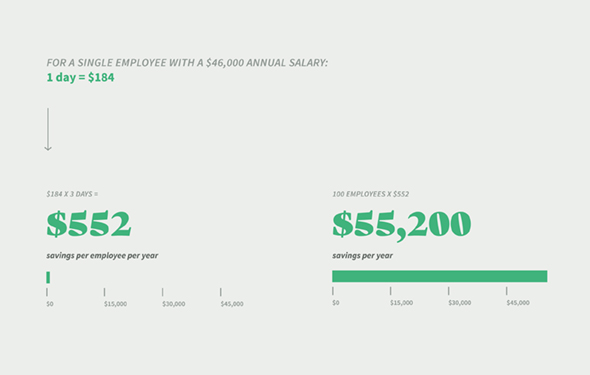
The other benefits of effective time-off management software include:
- Efficiency- Automated time-off tracking helps you better manage employee absences, which cost businesses about six percent of annual payroll.
- High Performance- When employees enjoy effective time-off management software, customer satisfaction levels increase up to 10 percent.
Employee Self-Service
Perhaps the biggest time-consumer in an HR professional’s busy week is the endless stream of employee questions, whether they’re about benefits administration or changes in personal information.
Employee self-service HR software gives employees the ability to find answers to their own questions and manage their own personal information. This takes a huge burden off of HR’s plate and can reduce the amount of time required for administrative tasks by 40 to 60 percent. That means about two hours per day of extra time:
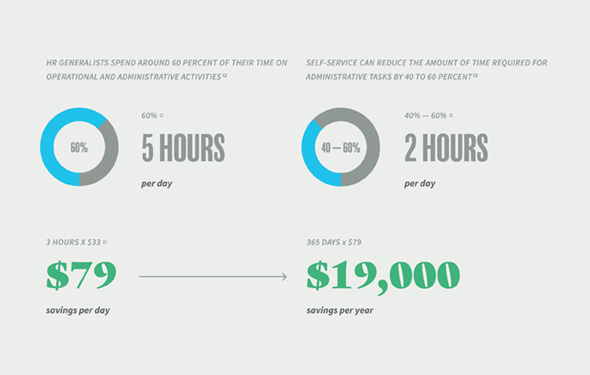
Using an employee self-service system in your organization provides other benefits as well:
- Efficiency- Employee self-service software allows HR to serve 10 percent more employees.
- Competitive Advantage- Self-service boosts your organization’s performance,
making those with such software about 50 percent more likely to achieve Best-in-Class status. - Performance & Productivity- 72 percent of HR generalists that use employee self-service in their organizations reported a lighter workload.
Totals Savings of HRIS
When you add all of the time and money savings together, the benefits of an HRIS are clear:
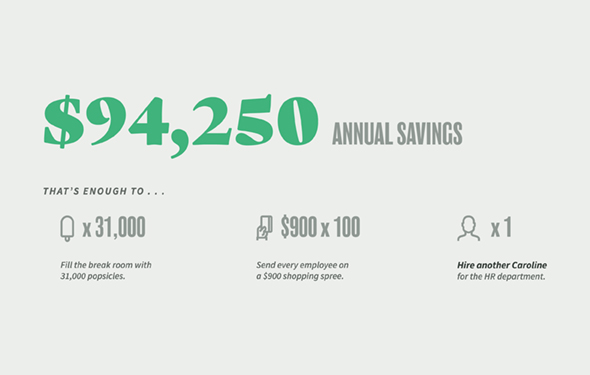
But it’s not just about time and money. An HRIS sets HR professionals like you free from worrying about the day-to-day operations and helps you to take a more strategic role in your organization. Start tackling turnover, boosting engagement, creating culture, and more with the right HR software on your side.
Ready for an HRIS to transform how you do HR? Schedule a free trial of BambooHR today!
Get caught up every month on all things HR. Don't worry, we promise we won't spam you.
Tori Fica is a copywriter for BambooHR, the leading HR software solution for small and medium businesses. Through research, analysis, and writing, she creates content to help HR professionals think and plan more strategically. Her focus is on taking complex ideas and in-depth research and turning them into clear, digestible pieces of content.









